What's inside
What's inside
 Key Ingredients
Key Ingredients

 Benefits
Benefits

 Concerns
Concerns

 Ingredients Side-by-side
Ingredients Side-by-side

Water
Skin ConditioningGlycerin
HumectantCyclopentasiloxane
EmollientPropanediol
SolventPhenoxyethanol
PreservativePentylene Glycol
Skin ConditioningSilica
AbrasiveAlcohol
AntimicrobialSynthetic Fluorphlogopite
Butylene Glycol
HumectantHydroxyethylcellulose
Emulsion StabilisingCI 77891
Cosmetic ColorantCetearyl Isononanoate
EmollientGellan Gum
Dimethicone/Vinyl Dimethicone Crosspolymer
Skin ConditioningCalcium Alginate
MaskingAcrylates/C10-30 Alkyl Acrylate Crosspolymer
Emulsion StabilisingParfum
MaskingDisodium EDTA
Tromethamine
BufferingSodium Hydroxide
BufferingPolymethylsilsesquioxane
CI 77491
Cosmetic ColorantTin Oxide
AbrasiveAlpha-Isomethyl Ionone
PerfumingBenzyl Benzoate
AntimicrobialBHT
AntioxidantDiamond Powder
AbrasiveTocopherol
AntioxidantWater, Glycerin, Cyclopentasiloxane, Propanediol, Phenoxyethanol, Pentylene Glycol, Silica, Alcohol, Synthetic Fluorphlogopite, Butylene Glycol, Hydroxyethylcellulose, CI 77891, Cetearyl Isononanoate, Gellan Gum, Dimethicone/Vinyl Dimethicone Crosspolymer, Calcium Alginate, Acrylates/C10-30 Alkyl Acrylate Crosspolymer, Parfum, Disodium EDTA, Tromethamine, Sodium Hydroxide, Polymethylsilsesquioxane, CI 77491, Tin Oxide, Alpha-Isomethyl Ionone, Benzyl Benzoate, BHT, Diamond Powder, Tocopherol
Water
Skin ConditioningDimethicone
EmollientButylene Glycol
HumectantGlycerin
HumectantPhenyl Trimethicone
Skin ConditioningVinyl Dimethicone/Methicone Silsesquioxane Crosspolymer
CI 77891
Cosmetic ColorantAlcohol
AntimicrobialPEG/PPG-18/18 Dimethicone
EmulsifyingC12-15 Alkyl Benzoate
AntimicrobialSodium Chloride
MaskingSilica
AbrasiveSynthetic Fluorphlogopite
Bisabolol
MaskingParfum
MaskingEthylhexylglycerin
Skin ConditioningDisodium EDTA
Stearalkonium Hectorite
Gel FormingPropylene Carbonate
SolventAluminum Hydroxide
EmollientCI 77492
Cosmetic ColorantCI 42090
Cosmetic ColorantHexyl Cinnamal
PerfumingBenzyl Benzoate
AntimicrobialSodium Lauroyl Glutamate
Butylphenyl Methylpropional
PerfumingPhenoxyethanol
PreservativeLysine
Skin ConditioningAlpha-Isomethyl Ionone
PerfumingMagnesium Chloride
Furcellaria Lumbricalis Extract
Skin ConditioningPancratium Maritimum Extract
BleachingLinalool
PerfumingCitronellol
PerfumingLimonene
PerfumingEugenol
PerfumingCamellia Sinensis Leaf Extract
AntimicrobialTriethoxycaprylylsilane
Lapsana Communis Flower/Leaf/Stem Extract
Skin ConditioningMaris Sal
Skin ConditioningWater, Dimethicone, Butylene Glycol, Glycerin, Phenyl Trimethicone, Vinyl Dimethicone/Methicone Silsesquioxane Crosspolymer, CI 77891, Alcohol, PEG/PPG-18/18 Dimethicone, C12-15 Alkyl Benzoate, Sodium Chloride, Silica, Synthetic Fluorphlogopite, Bisabolol, Parfum, Ethylhexylglycerin, Disodium EDTA, Stearalkonium Hectorite, Propylene Carbonate, Aluminum Hydroxide, CI 77492, CI 42090, Hexyl Cinnamal, Benzyl Benzoate, Sodium Lauroyl Glutamate, Butylphenyl Methylpropional, Phenoxyethanol, Lysine, Alpha-Isomethyl Ionone, Magnesium Chloride, Furcellaria Lumbricalis Extract, Pancratium Maritimum Extract, Linalool, Citronellol, Limonene, Eugenol, Camellia Sinensis Leaf Extract, Triethoxycaprylylsilane, Lapsana Communis Flower/Leaf/Stem Extract, Maris Sal
Ingredients Explained
These ingredients are found in both products.
Ingredients higher up in an ingredient list are typically present in a larger amount.
Alcohol comes in many different forms. Different types of alcohol will have different effects on skin. This ingredient is usually an astringent alcohol.
These alcohols are drying on the skin. They may strip away your skin's natural oils and even damage your skin barrier. Astringent alcohols may also irritate skin.
Other types of astringent alcohols include:
According to the National Rosacea Society based in the US, you should be mindful of products with these alcohols in the top half of ingredients.
Any type of sanitizing product will have high amounts of alcohol to help kill bacteria and viruses.
Fatty alcohols come from plant oils such as coconut oil. These can help hydrate the skin and are non-irritating. Some fatty alcohols include cetyl and stearyl alcohol.
Learn more about AlcoholAlpha-Isomethyl Ionone is a fragrance. It can be synthetically created or naturally occurring.
The scent of Alpha-Isomethyl Ionone is described as "flowery" but can also be "woody".
Naturally occurring Alpha-Isomethyl Ionone may be found in Saccharomyces cerevisiae, or the yeast used to make wine and bread.
The term 'fragrance' is not regulated in many countries. In many cases, it is up to the brand to define this term. For instance, many brands choose to label themselves as "fragrance-free" because they are not using synthetic fragrances. However, their products may still contain ingredients such as essential oils that are considered a fragrance.
Learn more about Alpha-Isomethyl IononeBenzyl Benzoate is usually created from the condensation of benzoic acid and benzyl alcohol. It is used as a preservative, solvent, and has a floral/balsamic scent in large amounts.
As a preservative, Benzyl Benzoate works against bacteria and fungus. It is often used to treat scabies and lice in medicine.
Solvents are used to keep ingredients together in a product. They can help dissolve ingredients to stable bases or help evenly distribute ingredients throughout the product.
Due to its fragrance, Benzyl Benzoate can be sensitizing and may cause contact dermatitis. It is a known EU allergen. We recommend speaking with a professional if you have any concerns.
Benzyl Benzoate can be naturally found in cranberries and peaches.
Learn more about Benzyl BenzoateButylene Glycol (or BG) is used within cosmetic products for a few different reasons:
Overall, Butylene Glycol is a safe and well-rounded ingredient that works well with other ingredients.
Though this ingredient works well with most skin types, some people with sensitive skin may experience a reaction such as allergic rashes, closed comedones, or itchiness.
Learn more about Butylene GlycolCi 77891 is a white pigment from Titanium dioxide. It is naturally found in minerals such as rutile and ilmenite.
It's main function is to add a white color to cosmetics. It can also be mixed with other colors to create different shades.
Ci 77891 is commonly found in sunscreens due to its ability to block UV rays.
Learn more about CI 77891Disodium EDTA plays a role in making products more stable by aiding other preservatives.
It is a chelating agent, meaning it neutralizes metal ions that may be found in a product.
Disodium EDTA is a salt of edetic acid and is found to be safe in cosmetic ingredients.
Learn more about Disodium EDTAGlycerin is already naturally found in your skin. It helps moisturize and protect your skin.
A study from 2016 found glycerin to be more effective as a humectant than AHAs and hyaluronic acid.
As a humectant, it helps the skin stay hydrated by pulling moisture to your skin. The low molecular weight of glycerin allows it to pull moisture into the deeper layers of your skin.
Hydrated skin improves your skin barrier; Your skin barrier helps protect against irritants and bacteria.
Glycerin has also been found to have antimicrobial and antiviral properties. Due to these properties, glycerin is often used in wound and burn treatments.
In cosmetics, glycerin is usually derived from plants such as soybean or palm. However, it can also be sourced from animals, such as tallow or animal fat.
This ingredient is organic, colorless, odorless, and non-toxic.
Glycerin is the name for this ingredient in American English. British English uses Glycerol/Glycerine.
Learn more about GlycerinParfum is a catch-all term for an ingredient or more that is used to give a scent to products.
Also called "fragrance", this ingredient can be a blend of hundreds of chemicals or plant oils. This means every product with "fragrance" or "parfum" in the ingredients list is a different mixture.
For instance, Habanolide is a proprietary trade name for a specific aroma chemical. When used as a fragrance ingredient in cosmetics, most aroma chemicals fall under the broad labeling category of “FRAGRANCE” or “PARFUM” according to EU and US regulations.
The term 'parfum' or 'fragrance' is not regulated in many countries. In many cases, it is up to the brand to define this term.
For instance, many brands choose to label themselves as "fragrance-free" because they are not using synthetic fragrances. However, their products may still contain ingredients such as essential oils that are considered a fragrance by INCI standards.
One example is Calendula flower extract. Calendula is an essential oil that still imparts a scent or 'fragrance'.
Depending on the blend, the ingredients in the mixture can cause allergies and sensitivities on the skin. Some ingredients that are known EU allergens include linalool and citronellol.
Parfum can also be used to mask or cover an unpleasant scent.
The bottom line is: not all fragrances/parfum/ingredients are created equally. If you are worried about fragrances, we recommend taking a closer look at an ingredient. And of course, we always recommend speaking with a professional.
Learn more about ParfumPhenoxyethanol is a preservative that has germicide, antimicrobial, and aromatic properties. Studies show that phenoxyethanol can prevent microbial growth. By itself, it has a scent that is similar to that of a rose.
It's often used in formulations along with Caprylyl Glycol to preserve the shelf life of products.
Silica, also known as silicon dioxide, is a naturally occurring mineral. It is used as a fine, spherical, and porous powder in cosmetics.
Though it has exfoliant properties, the function of silica varies depending on the product.
The unique structure of silica enhances the spreadability and adds smoothness, making it a great texture enhancer.
It is also used as an active carrier, emulsifier, and mattifier due to its ability to absorb excess oil.
In some products, tiny microneedles called spicules are made from silica or hydrolyzed sponge. When you rub them in, they lightly polish away dead skin layers and enhance the penetration of active ingredients.
Learn more about SilicaSynthetic Fluorphlogopite is the synthethic version of mica. It consists of fluorine, aluminum and silicate.
Synthetic Fluorphlogopite is used to add volume to products.
It is considered non-irritating on the skin.
Learn more about Synthetic FluorphlogopiteWater. It's the most common cosmetic ingredient of all. You'll usually see it at the top of ingredient lists, meaning that it makes up the largest part of the product.
So why is it so popular? Water most often acts as a solvent - this means that it helps dissolve other ingredients into the formulation.
You'll also recognize water as that liquid we all need to stay alive. If you see this, drink a glass of water. Stay hydrated!
Learn more about Water